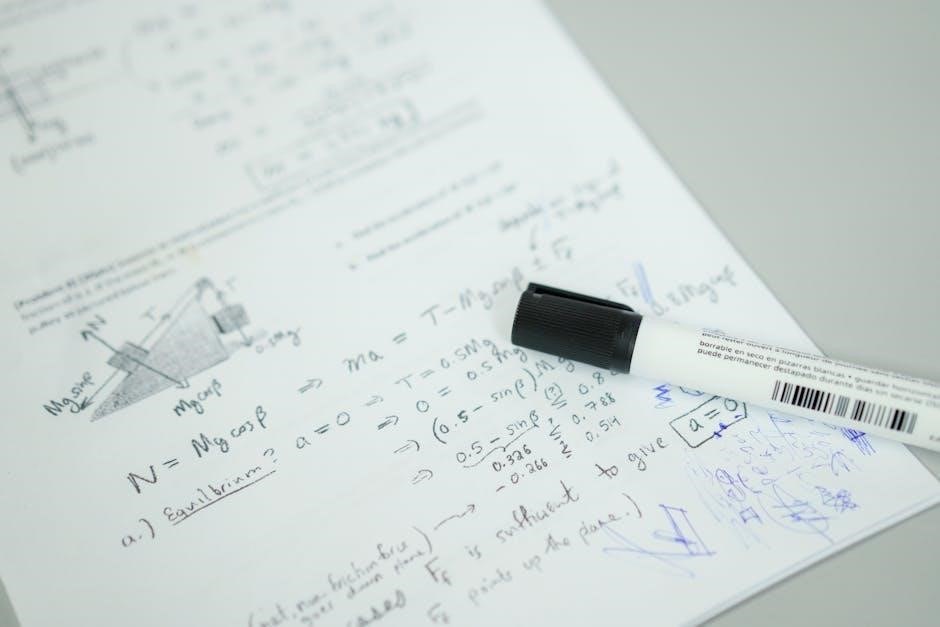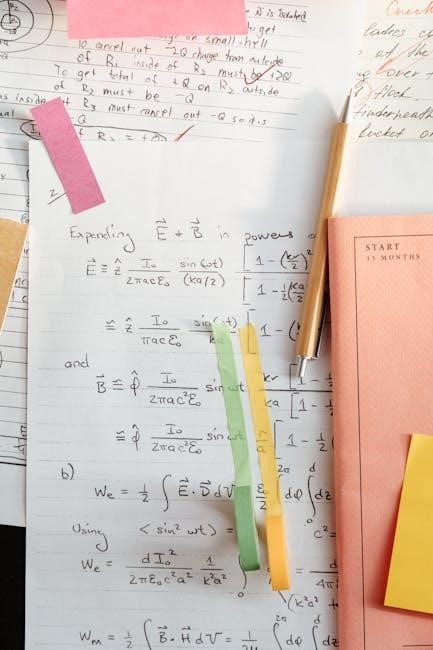Systems of equations word problems involve defining variables, setting up equations, and solving for unknowns. These problems apply mathematical concepts to real-world scenarios, enhancing problem-solving skills and practical application abilities. Worksheets with answers provide structured practice, helping students master techniques like substitution and elimination. They are essential for developing critical thinking and mathematical fluency in various contexts, from budgeting to resource allocation.
What Are Systems of Equations?
A system of equations is a set of two or more equations with the same variables. These equations are solved together to find the values of the variables that satisfy all equations simultaneously. Systems can be linear or nonlinear, depending on the degree of the equations. In word problems, systems often represent real-world scenarios, such as budgeting, resource allocation, or combined costs. Solving them requires defining variables, translating words into equations, and applying methods like substitution or elimination to find solutions.
Importance of Word Problems in Math Education
Word problems are essential in math education as they bridge abstract concepts and real-world applications. They enhance problem-solving skills by requiring students to interpret and translate scenarios into mathematical equations. Word problems foster critical thinking, creativity, and logical reasoning. They prepare students for practical situations, such as budgeting, resource allocation, and financial planning. Worksheets with answers provide structured practice, helping students build confidence and fluency in solving systems of equations. This approach ensures a deeper understanding of mathematical principles and their relevance in everyday life.
Benefits of Using Worksheets for Practice
Worksheets are invaluable for practicing systems of equations word problems. They provide structured exercises that help students build problem-solving skills and mathematical fluency. With answers included, worksheets enable self-assessment and immediate feedback, fostering independence and confidence. They also offer step-by-step solutions, guiding students through complex scenarios and reinforcing learning. Additionally, worksheets cater to different learning styles, making them a versatile tool for both classroom and home use. Regular practice with worksheets enhances understanding and prepares students for real-world applications of mathematical concepts.
Defining Variables and Setting Up Equations
Defining variables and setting up equations involves identifying key elements in word problems and translating them into mathematical expressions. This foundational step ensures accurate problem-solving in systems of equations.
Identifying Variables in Word Problems
Identifying variables in word problems involves pinpointing unknown quantities and assigning them names or symbols. For example, in a problem involving pizza costs, variables might represent the base price and topping cost. Similarly, in scenarios with combined pay, variables could denote hourly rates or total earnings. Clearly defining variables ensures equations accurately reflect the problem’s context. This step is crucial for setting up solvable systems of equations and applying methods like substitution or elimination effectively. Practice worksheets help refine this skill, enhancing problem-solving accuracy and speed.
Translating Words into Mathematical Equations
Translating words into mathematical equations requires careful interpretation of key terms and phrases. For example, “total cost” or “combined pay” often indicate sums, while “per item” suggests multiplication. Phrases like “more than” or “less than” signal addition or subtraction. Assigning variables to unknowns and converting sentences into algebraic expressions ensures clarity. Practice worksheets provide exercises like determining pizza costs or employee wages, helping students refine their ability to translate real-world scenarios into solvable equations. This skill is foundational for mastering systems of equations.
Common Mistakes to Avoid When Setting Up Equations

When setting up equations, common mistakes include misdefining variables, misinterpreting key terms, and incorrectly translating phrases into mathematical operations. For example, confusing “total cost” with “cost per item” or misapplying multiplication for combined quantities. Students often overlook negative signs or misassign variables, leading to incorrect equations; Additionally, assuming relationships without clear justification can introduce errors. Worksheets with answers highlight these pitfalls, emphasizing the importance of careful reading and logical translation of word problems into accurate mathematical expressions.

Solving Systems of Equations
Solving systems of equations involves substitution, elimination, or graphical methods to find variable values, essential for real-world problem-solving and critical thinking development.
Substitution Method
The substitution method involves solving one equation for a variable and substituting it into the other equation. This approach is systematic and reduces errors. For example, in a word problem involving costs, solve for one variable first, then substitute its value to find the other. This method is particularly effective for problems with clear relationships between variables, such as combined pay scenarios or purchasing items with multiple variables. It ensures accuracy and is widely used in various real-world applications, including budgeting and resource allocation.
Elimination Method
The elimination method involves manipulating equations to eliminate one variable by adding or subtracting them. This approach is effective for systems where coefficients can be easily adjusted. For example, in word problems involving combined pay or purchasing items, adjust equations to align coefficients, eliminate a variable, and solve for the remaining one. This method is systematic and reduces errors when applied correctly. It is particularly useful for problems with multiple variables, such as money or quantity scenarios, ensuring accurate and efficient solutions.
Graphical Method
The graphical method involves plotting the equations of a system on a graph to find their intersection point, which represents the solution. This visual approach is useful for understanding how two equations relate and for verifying solutions obtained through other methods. In word problems, such as those involving cost and topping scenarios or purchasing items, the graphical method provides a clear, intuitive way to see how variables interact. However, it may lack precision for complex systems, making it more of a supplementary tool for initial problem exploration.

Example Word Problems and Solutions
Example word problems demonstrate how systems of equations apply to real-life scenarios, such as budgeting, purchasing, and combined work hours, with step-by-step solutions for practice and understanding.
Cost and Topping Problems
Cost and topping problems involve calculating individual item prices based on total costs. For example, a large pizza costs $6.80 plus $0.90 per topping. If two pizzas with different toppings cost $10.50 and $12.30, students can define variables for the base pizza and topping costs, set up equations, and solve for each. These problems enhance algebraic skills and real-world application. Worksheets often include scenarios like purchasing vegetables or snacks, providing step-by-step solutions for practice and mastery of systems of equations.
Combined Pay and Work Hours Scenarios
Combined pay and work hours problems involve calculating individual rates based on total earnings. For example, Judy worked 8 hours and Ben worked 10 hours, with their combined pay totaling a specific amount. Students define variables for their hourly rates, set up equations, and solve for each. These scenarios simulate real-world labor and financial situations, helping students apply algebraic methods to practical problems. Worksheets often include step-by-step solutions, ensuring clarity and mastery of systems of equations in diverse contexts.
Purchasing Items with Multiple Variables
Purchasing problems often involve multiple variables, such as the cost of different items. For example, Julia bought 3 cans of chili and 2 jars of salsa for $10.07, while Marcia bought 2 cans and 4 jars for $12.98. Students define variables for each item’s cost, set up a system of equations, and solve for the unknowns; These scenarios mimic real-world shopping situations, teaching students to apply algebraic methods to multi-variable purchasing decisions. Worksheets with answers guide learners through defining variables and solving systems accurately.
Real-World Applications of Systems of Equations

Systems of equations are essential in business, finance, science, and engineering. They model scenarios like budgeting, resource allocation, and optimization, providing practical solutions to complex problems.
Business and Finance
In business, systems of equations are used to model budgeting, resource allocation, and pricing strategies. For instance, determining the cost of goods and services or optimizing profit margins can be achieved by solving these systems. Financial planners use them to manage investments and forecast revenue. Worksheets with real-world scenarios, like calculating the cost of pizza toppings or employee wages, help students apply mathematical concepts to practical business challenges, preparing them for career-related problem-solving.
Science and Engineering

In science and engineering, systems of equations are essential for modeling complex phenomena. For example, they are used to analyze electrical circuits, study population dynamics, and design structural systems. Worksheets with problems like determining the speed of currents or solving for variables in cyber-physical systems help students apply mathematical concepts to real-world challenges. These exercises prepare future scientists and engineers to tackle intricate problems, fostering analytical and problem-solving skills crucial for innovation and research.
Everyday Life Scenarios
Systems of equations are invaluable in everyday life, helping solve practical problems like budgeting, shopping, and planning events. For instance, determining the cost of items with multiple variables or allocating resources efficiently can be modeled using equations. Worksheets with real-world scenarios, such as purchasing groceries or tickets, teach students to apply math to daily decisions. These exercises enhance problem-solving skills, making math relevant and useful for navigating life’s challenges effectively.

Types of Word Problems
Word problems in systems of equations include two-variable, multi-step, and open-response or multiple-choice scenarios. Worksheets with answers provide practice in these areas, enhancing problem-solving skills.

Two-Variable Problems

Two-variable problems involve systems where two unknowns are related through equations. For example, determining the cost of squash and zucchini or the price of shirts and hats. These problems require defining variables, setting up equations based on the scenario, and solving the system. Worksheets with answers provide structured practice, ensuring students understand how to translate words into mathematical expressions. Two-variable problems are foundational, teaching students to apply algebraic methods to real-world situations, enhancing critical thinking and problem-solving skills.
Multi-Step Problems
Multi-step problems require students to break down complex scenarios into manageable parts. These problems often involve multiple variables and equations, demanding a systematic approach. For instance, scenarios like purchasing items with combined costs or calculating pay based on hours worked require defining variables, setting up equations, and solving step-by-step. Worksheets with answers guide students through these processes, enhancing their ability to handle intricate real-world situations. Multi-step problems foster analytical thinking and patience, as they often involve several layers of problem-solving before reaching a solution.
Open-Response vs. Multiple-Choice
Open-response questions require students to provide detailed solutions, showcasing their problem-solving process. This format encourages critical thinking and clear communication of mathematical reasoning. In contrast, multiple-choice questions offer quick assessments, testing students’ ability to select correct answers efficiently. Worksheets with answers often include both formats, allowing educators to cater to different learning needs. Open-response fosters deeper understanding, while multiple-choice provides immediate feedback. Both formats are valuable for evaluating mastery of systems of equations, ensuring comprehensive skill development and preparedness for various assessment styles.
Resources for Worksheets and Answers
Free PDF worksheets with answers are widely available online, offering step-by-step solutions and interactive tools. Websites like Kuta Software and Infinite Algebra provide customizable resources for practice.
Free PDF Worksheets Available Online
Free PDF worksheets with systems of equations word problems and answers are readily available online. These resources, often created by educators and platforms like Kuta Software, provide structured practice. Worksheets typically include a variety of scenarios, such as budgeting, combined pay, and purchasing items, to apply mathematical concepts. Step-by-step solutions guide students through defining variables, setting up equations, and solving systems using substitution or elimination methods; These PDFs are ideal for classroom use or self-study, catering to different skill levels and learning needs.
Step-by-Step Solution Guides
Step-by-step solution guides are invaluable for mastering systems of equations word problems; These guides break down each problem into manageable parts, from defining variables to solving equations. They often include examples with detailed explanations, making complex concepts easier to understand. Many guides use substitution and elimination methods, providing clear instructions for each step. Suitable for both classroom and independent learning, these resources help students build confidence and accuracy in solving real-world math problems. They are widely available online, catering to various skill levels and learning styles.
Interactive Tools for Practice
Interactive tools offer dynamic ways to practice systems of equations word problems. Platforms like Kuta Software and Infinite Algebra provide customizable worksheets and real-time feedback. These tools allow students to explore problems step-by-step, visualizing solutions and understanding each method. Many include features like problem generators, enabling users to create unlimited practice sets. Interactive tools enhance engagement and understanding, making them ideal for both classroom and self-study. They cater to diverse learning styles, ensuring students can master systems of equations at their own pace with immediate support and guidance.
Creating Your Own Worksheets
Creating custom worksheets allows for tailored practice. Tools like Kuta Software and Infinite Algebra enable educators to design relevant, clear problems. This enhances learning effectiveness and engagement.
Designing Relevant Word Problems
Designing relevant word problems involves creating scenarios that resonate with students’ lives, such as budgeting, shopping, or work hours. Use clear, concise language and real-world contexts to engage learners. Ensure problems align with curriculum goals and skill levels. Incorporate multiple steps and variables to challenge critical thinking. Provide answers for self-assessment and understanding. Tools like Kuta Software simplify creating diverse, tailored problems, making practice more effective and enjoyable for students.
Formatting for Clarity
Formatting word problems with clarity ensures readability and understanding. Use clean layouts with proper spacing, legible fonts, and clear headings. Organize problems sequentially, with each problem numbered and separated. Include instructions at the top and answer sections at the bottom. Highlight key terms and use consistent formatting for variables and equations. Ensure worksheets are visually appealing to engage students. Proper formatting helps students focus on problem-solving rather than navigating confusing layouts, making practice more efficient and effective for learning.
Using Software like Kuta to Generate Problems
Software like Kuta offers a user-friendly platform to create custom systems of equations word problems. Teachers can generate worksheets tailored to specific needs, ensuring relevance and difficulty alignment. Kuta’s tools allow for randomization of coefficients and constants, providing varied problems for practice. The software also supports answer key generation, saving time and ensuring accuracy. With a free trial available, educators can explore its features, making it an efficient resource for creating engaging and effective practice materials for students.
Mastery of systems of equations word problems enhances problem-solving skills and applies to real-world scenarios. Regular practice with worksheets and digital tools ensures confidence and fluency in math.
Systems of equations word problems require defining variables, translating words into equations, and solving using methods like substitution or elimination. Practice worksheets with answers help students master these skills, applying them to real-world scenarios such as budgeting, resource allocation, and combined costs. Regular practice enhances problem-solving abilities, ensuring accuracy and confidence in mathematical applications. These exercises are essential for developing a strong foundation in algebra and its practical uses in everyday life and professional contexts.
Encouragement for Further Practice

Consistent practice with systems of equations word problems is key to mastering algebraic concepts. Utilize worksheets with answers to refine your skills in defining variables, setting up equations, and solving real-world scenarios. Explore free PDF resources and interactive tools for additional practice. Regularly tackling these problems enhances problem-solving abilities, builds confidence, and prepares you for advanced mathematical challenges. Embrace practice as an opportunity to strengthen your understanding and apply these skills to everyday situations and future academic pursuits.
